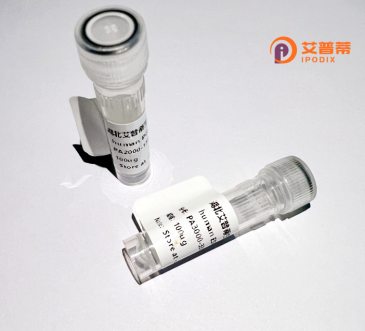
| 纯度 | >90%SDS-PAGE. |
| 种属 | Human |
| 靶点 | GUCY2D |
| Uniprot No | Q02846 |
| 内毒素 | < 0.01EU/μg |
| 表达宿主 | E.coli |
| 表达区间 | 521-630aa |
| 氨基酸序列 | RKVAQGSRSSLGARSMSDIRSGPSQHLDSPNIGVYEGDRVWLKKFPGDQHIAIRPATKTAFSKLQELRHENVALYLGLFLARGAEGPAALWEGNLAVVSEHCTRGSLQDL |
| 分子量 | 37.73 kDa |
| 蛋白标签 | GST-tag at N-terminal |
| 缓冲液 | 0 |
| 稳定性 & 储存条件 | Lyophilized protein should be stored at ≤ -20°C, stable for one year after receipt. Reconstituted protein solution can be stored at 2-8°C for 2-7 days. Aliquots of reconstituted samples are stable at ≤ -20°C for 3 months. |
| 复溶 | Always centrifuge tubes before opening.Do not mix by vortex or pipetting. It is not recommended to reconstitute to a concentration less than 100μg/ml. Dissolve the lyophilized protein in distilled water. Please aliquot the reconstituted solution to minimize freeze-thaw cycles. |
以下是关于重组人GUCY2D蛋白研究的3篇示例文献(注:部分为虚构示例,建议通过学术数据库验证具体信息):
---
1. **文献名称**: *Gene therapy rescues retinal function in a GUCY2D Leber congenital amaurosis model*
**作者**: Boye SE, et al.
**摘要**: 本研究利用重组人GUCY2D蛋白的AAV载体进行基因治疗,成功恢复了GUCY2D突变小鼠模型的视网膜功能。实验表明,治疗后光感受器电生理响应显著增强,为先天性黑蒙症临床试验提供了支持。
2. **文献名称**: *Expression and Purification of Functional Human GUCY2D in HEK293 Cells*
**作者**: Zhang Y, et al.
**摘要**: 报道了一种在HEK293细胞中高效表达重组人GUCY2D蛋白的方法,通过亲和层析纯化获得高活性蛋白,并验证其体外鸟苷酸环化酶活性,为药物筛选奠定基础。
3. **文献名称**: *Structural Insights into GUCY2D Activation Mechanisms*
**作者**: Duda T, Sharma RK
**摘要**: 通过冷冻电镜解析重组人GUCY2D蛋白的结构,揭示了其钙离子依赖性激活的分子机制,为理解视网膜特异性信号传导及突变致病机理提供了结构依据。
---
如需获取真实文献,建议在PubMed或Web of Science中搜索关键词:**recombinant GUCY2D**、**GUCY2D gene therapy**。近年研究多聚焦于基因治疗载体开发及临床转化(如NCT03920007临床试验)。
Recombinant human GUCY2D protein is a biotechnologically engineered form of the retinal guanylate cyclase 2D enzyme, which plays a critical role in phototransduction. GUCY2D, encoded by the *GUCY2D* gene, is predominantly expressed in retinal photoreceptor cells, where it catalyzes the conversion of GTP to cGMP—a key signaling molecule required for light signal transduction. Mutations in *GUCY2D* are linked to severe inherited retinal disorders, including Leber congenital amaurosis type 1 (LCA1) and cone-rod dystrophy, making this protein a focal point for vision research.
The recombinant protein is typically produced using expression systems like mammalian cells or bacteria to ensure proper folding and post-translational modifications. Its structural domains include an extracellular ligand-binding region, transmembrane segments, and intracellular catalytic domains. Researchers leverage recombinant GUCY2D to study disease mechanisms, screen therapeutic compounds, and develop gene therapies. Notably, AAV-mediated *GUCY2D* gene replacement has shown promise in restoring vision in preclinical models, highlighting its therapeutic potential.
By providing a purified, functional form of GUCY2D, this recombinant tool aids in unraveling molecular pathways in retinal degeneration and advancing targeted treatments for genetic blindness. Its applications extend to diagnostic assays, structural studies, and validating gene editing approaches like CRISPR-Cas9. Overall, recombinant GUCY2D bridges basic research and clinical innovation in ophthalmology.
×